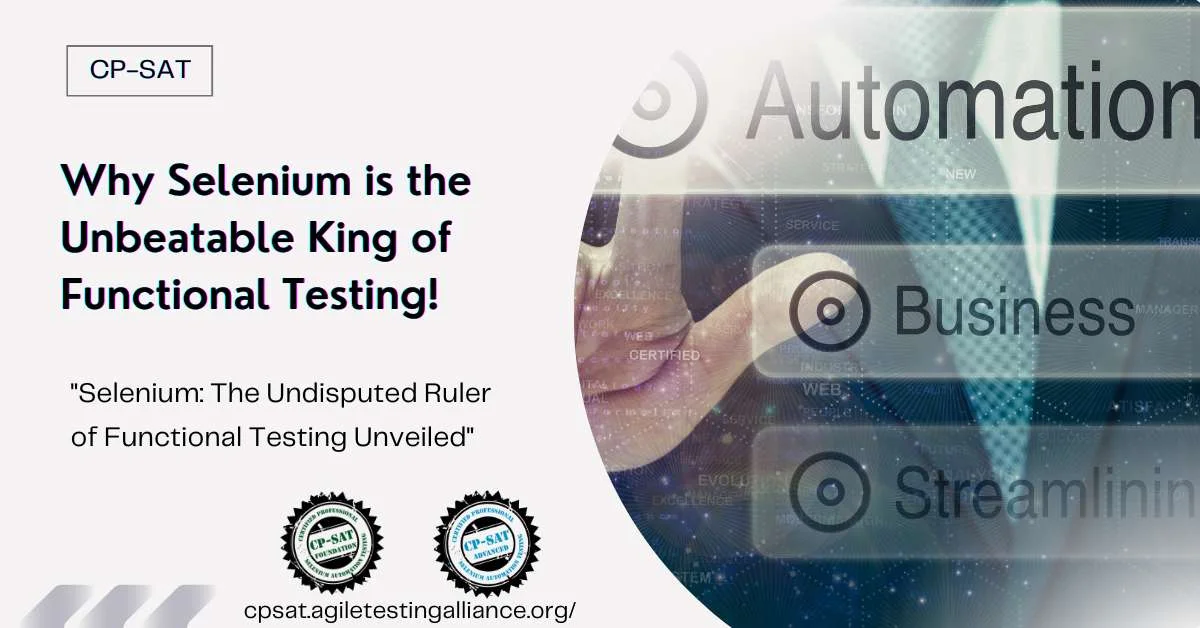
Why Selenium is the Unbeatable King of Functional Testing!

Table of Contents
Welcome to the fascinating realm of functional testing! If you’re a newcomer or an experienced professional in the field, you’re about to discover why Selenium stands head and shoulders above the rest as the “Unbeatable King of Functional Testing.” In an era where a seamless user experience is not just desired but expected, choosing the right tool for functional testing becomes a critical decision. Selenium, an open-source framework, emerged as the cornerstone of this transformation, offering not just automation but also unparalleled flexibility and versatility.
But what sets Selenium apart from other testing frameworks like QTP, JUnit, and TestComplete? The answer lies in its unique offerings. First, it’s open-source; you get a high-quality, robust testing environment without the price tag. Second, it provides unmatched flexibility. You can write test scripts in multiple programming languages like Java, C#, or Python and run them on a variety of browsers and operating systems. Whether you’re an aspiring tester in India, an automation aficionado in Silicon Valley, or a DevOps engineer in Berlin, this guide aims to be your ultimate resource for understanding the power and capabilities of Selenium. So sit back and prepare to unlock the secrets of perfect functional testing. Let’s dive in!
The Rise of Selenium: Charting the Meteoric Journey
Just a few years ago, the testing landscape was ruled by proprietary tools that came with a heavy price tag and a steep learning curve. That’s when Selenium disrupted the status quo, providing a cost-effective yet powerful alternative. It started as a humble project and quickly soared to unprecedented popularity. How did it manage to climb the ranks? It’s simple: by meeting the needs of testers in ways that other platforms couldn’t. The rise of Selenium can be traced back to a few key attributes that set it apart from the pack.
Firstly, let’s talk about flexibility—a word that’s practically synonymous with Selenium. Being an open-source tool, Selenium gives testers the freedom to script in multiple programming languages, including Java, Python, and C#. This feature is a godsend for freshers who might have learned a particular language in their educational journey. It also means that global teams can collaborate more easily, without worrying about language barriers in their code.
Secondly, cross-browser compatibility is a breeze with Selenium. Whether you’re using Google Chrome, Mozilla Firefox, or even Internet Explorer, Selenium has got you covered. This is vital in today’s diverse tech environment, where a product must perform consistently across a wide range of platforms to succeed.
Moreover, Selenium integrated seamlessly into the DevOps and Continuous Integration/Continuous Deployment (CI/CD) pipelines, making it a darling in modern agile settings. Companies worldwide—from startups in Bangalore to tech giants in Silicon Valley—have incorporated Selenium into their CI/CD pipelines, speeding up release cycles without compromising quality.
Finally, the community support. Oh, the community! Being an open-source tool means a vast, active community that contributes to its growth. Forums, tutorials, and third-party utilities abound, which is invaluable for both seasoned professionals and newcomers.
So, whether you’re a fledgling tester or a seasoned professional, it’s easy to see why Selenium is quickly becoming the go-to framework for functional testing. Its ascent to the top isn’t just luck or timing; it’s a result of features and benefits that meet the real-world needs of testers across the globe.
Core Features that Make Selenium Stand Out
When you delve into the world of Selenium, what you’ll find is an ecosystem replete with features that not only make your life as a tester easier but also enable more robust and comprehensive testing. Let’s navigate through these features, some of which act as the core pillars supporting Selenium’s unparalleled reputation in functional testing.
First off, let’s dig into the capability of multiple language support. If you’re a fresher just stepping into the professional arena, you’ll appreciate that Selenium doesn’t tie you down to a specific programming language. Whether you learned Java, Python, or C# in college, you can seamlessly transition into Selenium testing. It’s like the United Nations of programming languages; whether you’re in New York or New Delhi, you’ll find a home here.
Next on the list is the feature everyone’s talking about: cross-browser testing. Let’s face it, your users are not all using the same browser. So why should your testing be limited to one? Selenium embraces this diversity by offering extensive compatibility across leading web browsers such as Chrome, Firefox, and even the not-so-popular ones like Safari and Internet Explorer. This ensures your product’s functionality remains consistent, irrespective of the browsing environment.
Don’t underestimate the power of Selenium Grid, another core feature that’s revolutionizing the way we conduct parallel testing. Imagine running multiple tests at the same time across different browsers and operating systems. The Grid makes this a reality, catapulting your testing efficiency to new heights. For a newbie, this means faster learning curves and quicker, more efficient workflows.
Speaking of efficiency, how can we overlook Selenium’s ease of integration with other tools and frameworks? Whether it’s Maven for project building, TestNG for reporting, or Jenkins for continuous integration, Selenium plays well with others. And let’s not forget its crucial role in DevOps, where automated testing is not a luxury but a necessity.
Lastly, the community support is something that deserves a standing ovation. An open-source tool thrives on its community, and Selenium is no different. Countless tutorials, forums, and open-source plugins are available at your fingertips, making it the perfect playground for newcomers who are eager to learn and contribute.
In summary, Selenium isn’t just another tool in the market; it’s a full-fledged testing framework that caters to a wide range of needs, from basic to advanced. Its unique combination of flexibility, compatibility, and community support makes it not just a tool but a comprehensive testing solution. It’s no wonder that Selenium is setting a gold standard in functional testing.
Hands-On: Getting Started with Selenium
If you’re just breaking into the testing industry or looking to pivot from another technical role, welcome aboard! Now, enough with the niceties—let’s roll up our sleeves and dive straight into the nitty-gritty of Selenium. Getting started with this powerhouse tool might seem intimidating at first, but trust me, it’s simpler than you think. So, what’s the roadmap for kick-starting your Selenium journey?
First and foremost, let’s set the stage by installing Selenium. Don’t break into a sweat; it’s as easy as downloading a web driver for the browser you wish to test on. Chrome, Firefox, Safari—you name it, Selenium has it. Once you’ve got the web driver, place it in your system path and you’re good to go. For those using an Integrated Development Environment (IDE) like Eclipse or IntelliJ, adding Selenium libraries to your project can be done in a jiffy. If this sounds like gibberish to you, don’t worry. Plenty of online tutorials and community forums are there to guide you, step-by-step.
Now, let’s talk about writing your first test script. Pick a programming language you’re comfortable with; let’s say Python for argument’s sake. With just a few lines of code, you can launch a browser, navigate to a web page, perform actions like click and type, and even validate responses. It’s like having a digital assistant who never calls in sick! And the best part? You can execute this script across multiple browsers, thanks to Selenium’s cross-browser compatibility. You see, Selenium isn’t just about running automated tests; it’s about replicating real-world user interactions to ensure your application’s functionalities are up to snuff.
What’s next? Ah yes, debugging and reporting—often considered the bread and butter of testing. With tools like TestNG and Selenium Grid, you can not only pinpoint the areas causing the hiccup but also run parallel tests to save time. Remember, time is of the essence in today’s fast-paced tech world, and Selenium ensures you don’t lag behind.
So, there you have it—your beginner’s guide to taking the plunge into the realm of Selenium testing. As you can see, Selenium is not just a tool but a complete ecosystem that allows you to perform robust, efficient, and comprehensive testing. And guess what? You don’t have to go at it alone. The vibrant Selenium community is always eager to help, offering a plethora of resources tailored for newcomers.
In a nutshell, whether you’re in Sydney or San Francisco, a seasoned tester or a fresh-out-of-college newbie, Selenium offers a world of opportunities to explore, learn, and grow. So why wait? Take the leap, and you won’t regret it.
The Ecosystem Around Selenium
Hold onto your hats, testing enthusiasts! If you thought Selenium was just about automation libraries and web drivers, you’re in for a sweet surprise. The ecosystem around Selenium is vast and incredibly dynamic, packed with a wide array of supporting tools, integrations, and community contributions. Let’s unravel this fascinating tapestry, shall we?
First off, let’s talk about Selenium Grid. It’s a lifesaver when you want to execute parallel tests across multiple browsers and operating systems. Imagine you’re in New York, but you need to make sure your app works flawlessly on a browser predominantly used in Tokyo. No sweat! With Selenium Grid, you can virtually span the globe to validate your app’s performance. Talk about being omnipresent!
Next in line is TestNG. Think of it as the Swiss Army knife for your testing framework. With features like test configuration, parallel test execution, and detailed reporting, TestNG supercharges Selenium, making it far more robust. Now, who wouldn’t want a little extra oomph?
And how can we overlook Continuous Integration/Continuous Deployment (CI/CD) platforms like Jenkins? Selenium integrates seamlessly with these tools to ensure that your application is not just developed but also deployed with minimal hitches. You write a test script, push the code, and voila! Jenkins takes over, running your Selenium tests as part of the build process. Automation has never been so easy!
Don’t forget the role of cloud-based testing platforms like Sauce Labs and BrowserStack. They further amplify Selenium’s capabilities by offering a scalable, maintenance-free environment where you can run tests without the logistical nightmares of setting up in-house test labs.
Finally, a shout-out to the thriving Selenium community. From detailed documentation to a plethora of tutorials, forums, and even dedicated Selenium conferences, the community is the backbone of this exceptional ecosystem. And let me let you in on a secret: this community loves helping newcomers. So, don’t hesitate to dive in and ask questions.
If you’re a fresher or a newcomer, the Selenium ecosystem has something for everyone, regardless of where you’re joining us from—be it Berlin or Bangalore. It’s not just about the technology; it’s about a global network of professionals who are as passionate about quality software as you are.
So, what are you waiting for? The world of Selenium is vast, rich, and incredibly welcoming. Whether you’re a seasoned expert or someone who’s just got their foot in the door, this ecosystem is where testing dreams come true. Start exploring now!
The Future of Selenium and Functional Testing
Ah, the future—a realm teeming with possibilities and innovations! In the landscape of functional testing, Selenium isn’t just sitting pretty; it’s accelerating at full throttle towards new horizons. So, if you’re a fresher or a newcomer to the world of testing, you’re hopping on a train that shows no signs of slowing down. Let’s gaze into the crystal ball and see what the future holds for Selenium and the broader realm of functional testing.
First, let’s cut straight to Artificial Intelligence (AI). When we talk about the future, how can we not talk about AI? Selenium is increasingly looking to integrate machine learning capabilities to make test automation smarter. Imagine predictive test scripts that can anticipate changes in the UI or adapt to new testing conditions! For you, that means less manual work and more focus on complex test cases. It’s like having a smart assistant by your side.
In addition, the Internet of Things (IoT) is not just a fancy buzzword; it’s a revolution that’s changing the way we live and work. The demand for testing IoT devices is on the rise, and guess what? Selenium is gearing up to be a significant player in this space. Interoperability testing, performance testing, and security testing for IoT—Selenium aims to have it all covered. This opens up a whole new world of opportunities for testers globally.
Also, keep your eyes peeled for containerization technologies like Docker. Selenium and Docker are becoming fast friends. Containers can simplify the complex process of setting up multiple test environments. Think of it as a ‘Testing Laboratory in a Box’—convenient, isn’t it?
Now, let’s talk community and collaboration. Open-source platforms thrive on collective knowledge, and the Selenium community is no different. The more the community grows, the faster the technology evolves. With contributors from every corner of the globe, the roadmap for Selenium promises continuous improvement and cutting-edge features. For freshers and newcomers, this is a playground for innovation and learning, with a universal language of quality assurance.
Finally, as cloud-based solutions become ubiquitous, Selenium is bound to integrate even more seamlessly with cloud services. We’re talking about elastic scalability, reduced costs, and the ability to run tests anywhere, anytime. The cloud is the limit!
So, freshers, don’t just stand on the sidelines—jump in! The future of Selenium and functional testing is a narrative in progress, and you can be a part of this thrilling story. Whether you’re in Sydney or San Francisco, this is a global movement. Come and be a part of the future that is not just promising but also incredibly exciting.
Why Selenium is the Unbeatable King of Functional Testing
When it comes to functional testing, if there’s a reigning monarch that sits unchallenged on the throne, it’s Selenium. Now, you might ask, “What’s the big deal? There are numerous tools available, so why is everyone so smitten with Selenium?” Well, allow me to elucidate, especially if you’re a fresher or newcomer stepping into the intriguing world of software testing. Trust me, after this, you won’t question why Selenium is often dubbed the “King of Functional Testing.”
First off, let’s talk flexibility and language support. Most testing tools compel you to stick to a specific programming language. But not Selenium! Whether you’re comfortable with Java, Python, C#, or Ruby, Selenium graciously accommodates you. It’s like a language polyglot, enabling you to write your test scripts in the language you are most comfortable with. This feature alone makes Selenium a crowd-pleaser, particularly appealing to a global audience of testers.
Now, on to the cross-browser compatibility. Think about it: your users aren’t all going to use the same web browser. Some may be loyal to Google Chrome, while others prefer Firefox or Safari. Selenium’s got it covered—your tests can run on virtually any browser you can think of. Moreover, it allows for parallel test execution, reducing test times and speeding up your deployment process.
Let’s put theory into practice with an example. Imagine you’re tasked with testing an e-commerce platform. With Selenium, you can write a single script in Python (or any language of your choice) that logs in, selects a category, picks an item, adds it to the cart, and goes through the checkout process. You can then execute this test across multiple browsers simultaneously. That’s not just efficient; it’s groundbreaking!
But hold on, the story doesn’t end here. Selenium boasts of an impressive ecosystem. It seamlessly integrates with other tools and platforms, from Jenkins for Continuous Integration to TestNG for test configuration and parallel execution. And then there’s Selenium Grid, which allows you to run tests on different machines across different browsers, simultaneously. It’s like an entire universe built around making your life easier!
Finally, let’s not forget that Selenium is open-source. No licensing fees, no hidden costs. It’s maintained by a community of enthusiastic developers and testers, which means you get the advantage of community support and frequent updates. The platform is transparent, and its architecture allows for contributions from testers worldwide, making it a global initiative aimed at enhancing quality assurance methods.
So, freshers and newcomers, listen up! In the realm of functional testing, Selenium isn’t just a tool; it’s a community, an ecosystem, and yes, a King. Whether you’re in Melbourne or Mumbai, it offers unparalleled advantages that make it universally revered. You don’t have to take my word for it—dive in and experience firsthand why Selenium wears the crown in functional testing.
Conclusion
In wrapping up, it’s hard to overlook the unparalleled prowess of Selenium in the landscape of functional testing. It’s more than just a tool; it’s an ecosystem, a community, and indeed, the undisputed King. If you’re a fresher or newcomer to the world of software testing, and you haven’t yet dabbled in Selenium, then you’re genuinely missing out on the gold standard of the industry.
What sets Selenium apart isn’t just its technical capabilities, though those are impressive. It’s the adaptability and scalability that it offers. Whether you’re working on a small-scale project or a multinational operation, Selenium can be tailored to fit your specific needs. And this adaptability isn’t just about the size of your project; it extends to the language you’re most comfortable writing in, the browser your end-users prefer, and even the operating system they’re using. This sort of holistic approach to functional testing is what makes Selenium unbeatable. And let’s not forget the power of open-source. With a robust community of testers and developers behind it, Selenium is ever-evolving, keeping pace with industry trends and technological advances. This makes it future-proof, a quality that is hard to find in today’s rapidly changing tech environment.
So, to all the freshers and newcomers in global software testing communities, this is your clarion call. Take the plunge into the world of Selenium. You’ll find that it’s not just a tool but a comprehensive solution for all your functional testing needs. With its multi-language support, cross-browser compatibility, and seamless integrations, Selenium is not just leading the pack; it’s defining the very framework upon which future testing tools will be judged. And that, dear readers, is why Selenium is, and will remain, the unbeatable King of Functional Testing.
FAQs
Great question! First off, Selenium is an open-source tool, which means it’s free to use and has a massive community of experts contributing to its development. This ensures that you always have the latest features and can seek guidance whenever you’re stuck. Plus, Selenium supports multiple programming languages like Java, Python, C#, and more, offering you the flexibility to use your language of choice.
Let’s clear the air: there’s a learning curve, but it’s not insurmountable. If you already have a basic understanding of programming and testing concepts, you’ll find Selenium to be a powerful yet user-friendly tool. There are tons of online resources, courses, and community forums that can help you grasp its nuances.
Absolutely, but indirectly. Selenium itself isn’t equipped for mobile testing, but its suite contains Selenium Grid and Appium that enable mobile application testing. So yes, within the Selenium ecosystem, you can extend your functional testing to mobile platforms as well.
Primarily, Selenium is designed for web application testing. However, the beauty of Selenium lies in its versatility. With the right configurations and additional tools like Selenium Grid, you can broaden its capabilities to include more than just web applications.
In a DevOps environment, automation is king, and Selenium fits like a glove. It seamlessly integrates with CI/CD pipelines, enabling continuous testing and ensuring high software quality at every stage of the development lifecycle.
Given its open-source nature, large community support, and adaptability to technological changes, it’s highly unlikely that Selenium will become obsolete anytime soon. It’s not just surviving; it’s thriving and evolving, setting the standards for functional testing tools to come.











